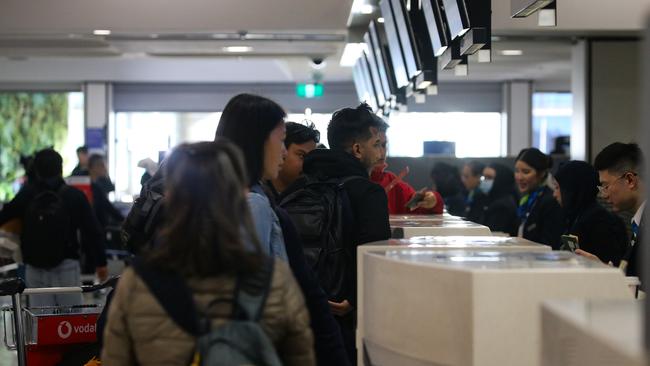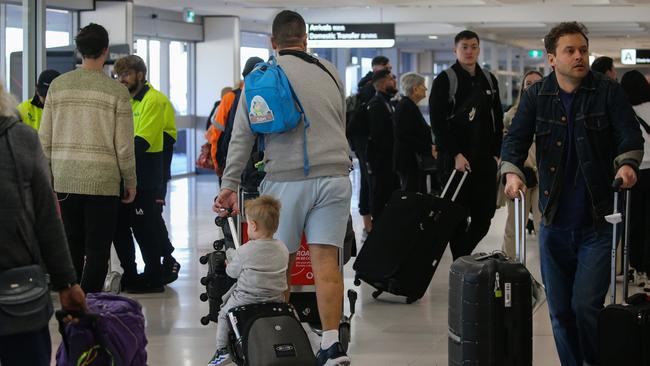New figures show personal loans up, new housing loan commitments down
As the Euro-summer holiday season is drawing to a close, new data reveals the truth behind some of the luxurious getaways.

Business
Don't miss out on the headlines from Business. Followed categories will be added to My News.
Australians took out more loans to pay for travel and holidays in July than they have in five years, new data has revealed.
After thousands of Australians headed to Europe to escape winter and the cost of living crunch back home, the latest lending indicators released from the Australian Bureau of Statistics show that some of them likely took out a personal loan to fund their trip.
The data reveals that while new loan commitments for housing fell 1.2 per cent in July, there was a 4.7 per cent increase for personal fixed term loans – up to $2.3bn after a fall in June.
In seasonally adjusted terms, the value of new loan commitments for travel and holidays rose 12.3 per cent from the month prior, to the highest level since August 2018 – $57m.
While more Australians are likely to use a credit card than take out a personal loan to help pay for their travel, Rachel Wastell from Mozo said it’s “not surprising to see the drive in demand for personal loans” after months of European holiday spam.

“After being stuck at home for essentially two years, Aussies are keen for a holiday, and using personal loans could be a great way to get the holiday of your dreams – as long as you have a clear plan on how to pay it back,” she said.
It wasn’t just for travel and holidays that Australians flocked to personal finance options, with the ABS data showing the value for new loans for cars was up 1.3 per cent, and rose 42.1 per cent for personal investment.
“Personal loans act as car loans, wedding loans, travel loans and more, and can be a great option for reckless spenders who need a break without the fear of double digit interest debt piling up when they get home,” Ms Wastell said.
“In August, some personal loan rate hikes were much larger than expected. This was interesting given an RBA (cash rate) pause last month, and a market consensus that the cash rate will remain at 4.1 per cent in September.
“Hume Bank and Australian Unity lifted some personal fixed rate loans by 100 basis points, but the big money move was from Alex Bank, which increased one fixed rate loan by more than 300 basis points.

The data also revealed the value of new home and investment property loans dropped for the second consecutive month to be 14.1 per cent lower than the same time last year.
Steve Mickenbecker from Canstar said while spring was usually the season for a housing boom, this year it looked to be “in the balance”.
“While new home lending remained subdued in July, house prices are continuing to rise around the country, but this has been on the back of low supply of housing hitting the market which could be about to change with spring upon us,” Mr Mickenbecker said.
“Demand for new housing is unlikely to rise until borrowers feel confident that interest rate rises are well behind us.
“First home buyers, hit hard by repayment affordability, are less likely to rush back into the market until interest rates fall.”
Loans to purchase commercial property fell 5.1 per cent, and business construction loans tumbled 21.5 per cent.
Meanwhile, the value of new owner-occupier loan commitments excluding refinancing fell 1.9 per cent to $15.6bn; with the value of new investor loan commitments falling slightly to $8.6bn.
A record $21.5bn in loans were switched to a new lender in July, up 5.4 per cent from the month prior and 21.8 per cent higher than the same time last year.
Mr Mickenbecker said the latest data showed borrower's’ willingness to shop around and chase a better interest rate had reached a new record high.
“Even though the Reserve Bank looks likely to pause the cash rate in September, there is still a huge population of borrowers who have yet to experience the bitter taste of a rate increase,” he said.
“Interest rate rises are the great motivator for refinancing as borrowers do what they can to offset Reserve Bank rate increases.”
It comes as new Roy Morgan data out this week suggests 1.5 million Australians, or about one third of all home loan borrowers, are at risk of mortgage stress as a result of the Reserve Bank’s long run of cash rate hikes.
Originally published as New figures show personal loans up, new housing loan commitments down


